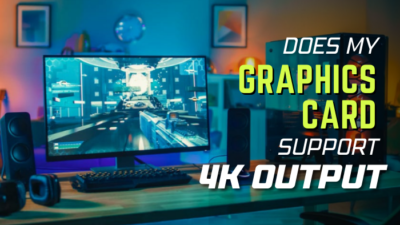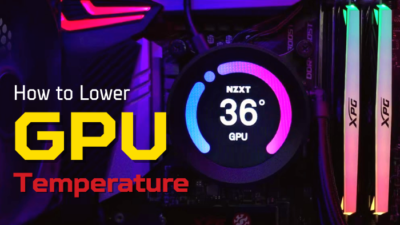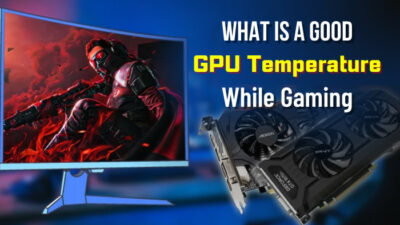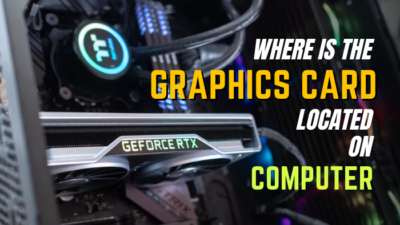Did you ever face a situation where people referred to multiple objects by the same name, or referred to a single object by various names?
Well, if you are facing the same issue with GPU, graphics cards, and video cards, you are not alone. Are all the same or have any differences?
This article will cover all the in and outs of graphics-related components. Without further discussion, let’s get started!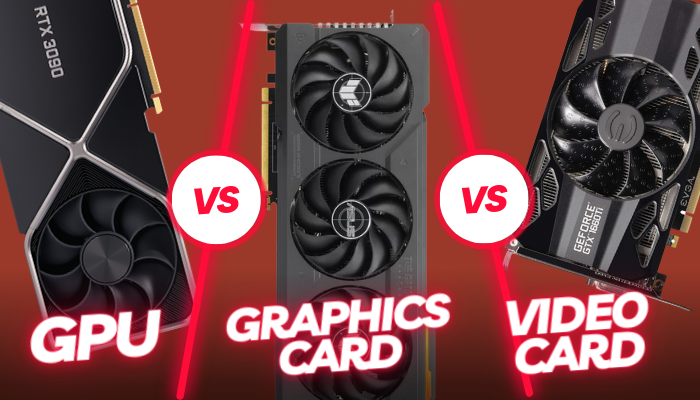
Go through our epic guide on confusion of Ti vs. non-Ti GPU.
What is a GPU (Graphics Processing Unit)?
The GPU acronym stands for Graphics Processing Unit. It is a specialized processor that was designed to speed up graphics rendering. The common size of a GPU is 3×3 cm, which consists of numerous electronic circuits logic, and cores on a flat chip.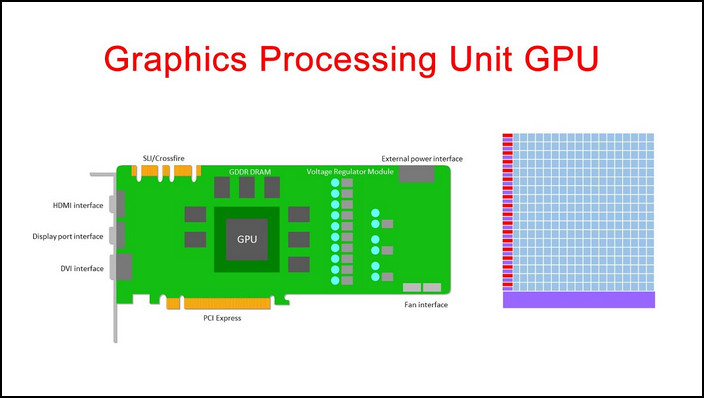
People often mix up the GPU with the Graphics Card. However, they are not the same. While a GPU is the main component of a graphics card that is responsible for the calculation and processing, the graphics card consists of several components, including GPU.
A GPU needs memory and power to process information, and the chip itself won’t be able to run any instructions without the help of those parts.
The graphics processing unit can be directly attached to the CPU, or it can come with its own PCB (Printed Circuit Board).
Directly integrated GPU into the CPU is known as iGPU (Integrated GPU). This type of GPU can connect with the other computer parts and access power, the system’s memory (RAM), and other connections through the CPU.
Contrarily, when the GPU comes into its own Printed Circuit Board, it is called a graphics card. For more information about a graphics card, move on to the next section.
Read more on do all CPUs have Integrated Graphics Card?
What is a Graphics Card?
The Graphics card is a printed circuit board that consists of several components such as power management, video random access memory (VRAM), and a cooling system. A graphics card also includes a BIOS chip to save the card settings and executes diagnostics during startup.
People often claim a graphics card as a dedicated Graphics Card because the card comes with all the hardware components that are needed to function properly.
Besides, the graphics card also includes a high-speed interconnect and the PCIe connector that is used to connect it to the motherboard to establish a connection with the rest of the computer parts.
Because of all the different components, a graphics card can be so expensive. But it’s worth the money, as it can generate a lot of additional power for the CPU to handle the most intensive apps and games.
Though graphics cards were designed to render graphics or visual outputs, nowadays, a graphics card can handle any possible workloads that can be parallelized.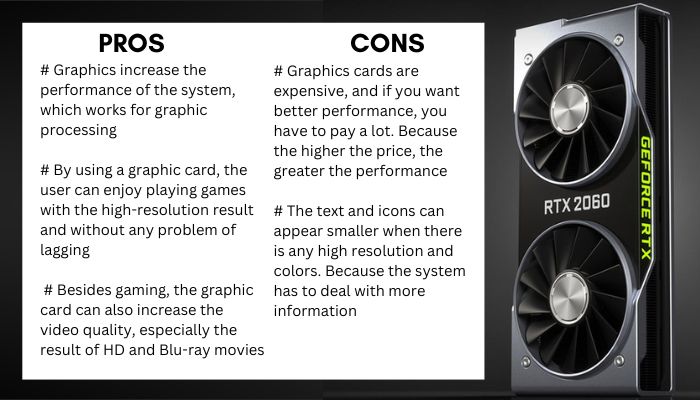
What is a Video Card?
A video card is also known as a video controller that deals with all video-related processing. A video card is an electronic circuit that consists of visual processing units, GPU, cooler, video BIOS, VRAM, RAMDAC, video graphics array, HDMI & display port, etc.
Display characteristics such as display colors, resolution, and image rendering speed are handled by the video card.
The video card is mainly focused on video-related processing like conversion, video editing, streaming, movie projecting, and so on. For higher-resolution video output, you will need more raw performance from the computer, and most computers cannot handle such workloads.
Using the video card, you can reduce the workload from the CPU, and as a specialized hardware for video processing, a video card can efficiently handle the workloads without a performance drop.
Furthermore, you may find some videos that have specific video codecs, and a traditional graphics card or CPU is not enough for handling such codecs.
In that case, you must go for a video card to ensure the rest of your system is not affected or dropping performance during encoding, decoding, outputting, or capturing videos.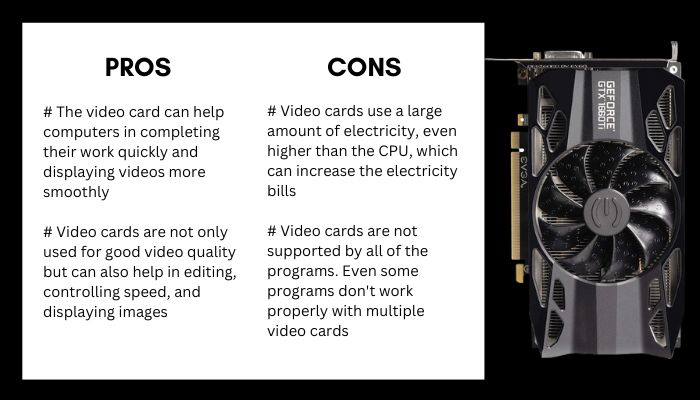
You may also like to read about how long do GPUs last?
Difference Between GPU, Graphics Card and Video Card
GPU, graphics card, and video card are usually used interchangeably because they are very identical. However, a GPU is the main component that processes rendering instructions, a graphics card is complete hardware with several components, and a video card is used for video-related processing.
Consider the following table for important differences between GPU, graphics card, and video card.
Here is the table of differences between GPU, graphics card, and video card:
| Parameters | GPU | Graphics Card | Video Card |
|---|---|---|---|
| Definition | GPU is the main image-processing chip. | Graphics card handles picture, video, and gaming quality. | Video cards deal with the resolution, display color, and rendering speed. |
| Usage | Used for image processing. | Primarily used for gaming. | Used for video editing, and multimedia projects. |
| Price | GPUs are cheaper compared to other components. | A graphics card is less expensive compared to a video card. | Video cards are highly costly. |
| Performance | Cannot perform individually. | The integrated graphics card is weaker than the dedicated video card. | Faster than a graphics card. |
| Purpose | For processing data. | Gaming and editing. | Controlling speed, display, video output, multiple video output, etc. |
The above table clearly represents the main differences between a GPU, a graphics card, and a video card.
Follow our guide to test if GPU is failing.
Frequently Asked Questions
Is A GPU the same as a video card?
A GPU is the main component of a graphics card that processes all visual and image-related information. Contrarily, a video card is a complete hardware that consists of a GPU, visual processing units, cooler, video BIOS, VRAM, etc.
Is video card and graphic card the same?
While a video card is mainly focused on video processing, the graphics card deals with all graphics-related rendering. However, they are technically the same, as they handle only visual outputs for output displays.
Do I need both a GPU and video card?
Choosing a video card or graphics card for your system is highly dependent on computer usage. You can have both if you often need to run more graphics-intensive and less graphics-intensive applications.
Ending Thoughts
The GPU is the main component for processing information, though it cannot run individually and needs support from a CPU or graphics card.
A graphics card is a functional piece of hardware consisting of various components including a GPU. Moreover, the video card is a special type of hardware that accelerates video-related processes.
Did this article answer all your questions? Comment below for further information.

